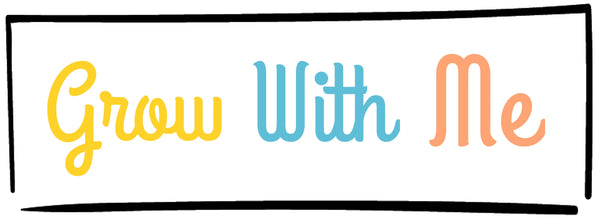
Top Picks: Best Educational Toys for 2 Year Olds in the UK
Share
When you think about the best educational toys for a 2-year-old, your mind might jump to fancy gadgets with flashing lights. But really, the magic lies in the simple, classic stuff—things like building blocks, chunky puzzles, and art supplies that let their imagination run wild.
The perfect toy isn't about the bells and whistles; it's about matching where your child is right now in their incredible developmental journey.
Your Guide to Educational Toys for 2 Year Olds
Picking the “best” toy can feel like a huge task, but the secret is to peek inside the mind of a two-year-old. This age is an explosion of growth—cognitively, physically, and socially. A truly great toy is simply a tool that supports this explosion, turning everyday play into a brilliant learning moment.
So, instead of chasing the latest electronic fad, think about toys that are built to last and can be used in a dozen different ways.
This back-to-basics approach is catching on with parents everywhere. In the UK, the demand for genuinely educational toys for toddlers (aged 1 to 3) is soaring, making up a massive 51% of the total market in 2023. It’s clear parents are looking for toys that offer both fun and real developmental value.
You can dive deeper into why these toys matter in our guide to developmental toys for toddlers.
To make it even easier, let's break down some of the most effective toy categories and see what skills they help nurture.
Top Educational Toy Categories and Their Benefits for 2 Year Olds
Here’s a quick look at the types of toys that deliver the biggest developmental punch at this age.
| Toy Category | Primary Skill Development | Examples |
|---|---|---|
| Building & Construction | Problem-solving, spatial awareness, fine motor skills | Wooden blocks, large interlocking bricks |
| Puzzles & Shape Sorters | Cognitive skills, hand-eye coordination, patience | Chunky wooden puzzles, shape sorting cubes |
| Imaginative Play | Social-emotional growth, language, creativity | Play kitchen, dolls, toy animals |
These categories provide a fantastic starting point because they grow with your child, offering new challenges as their skills develop.
Understanding How Your 2-Year-Old Learns Through Play
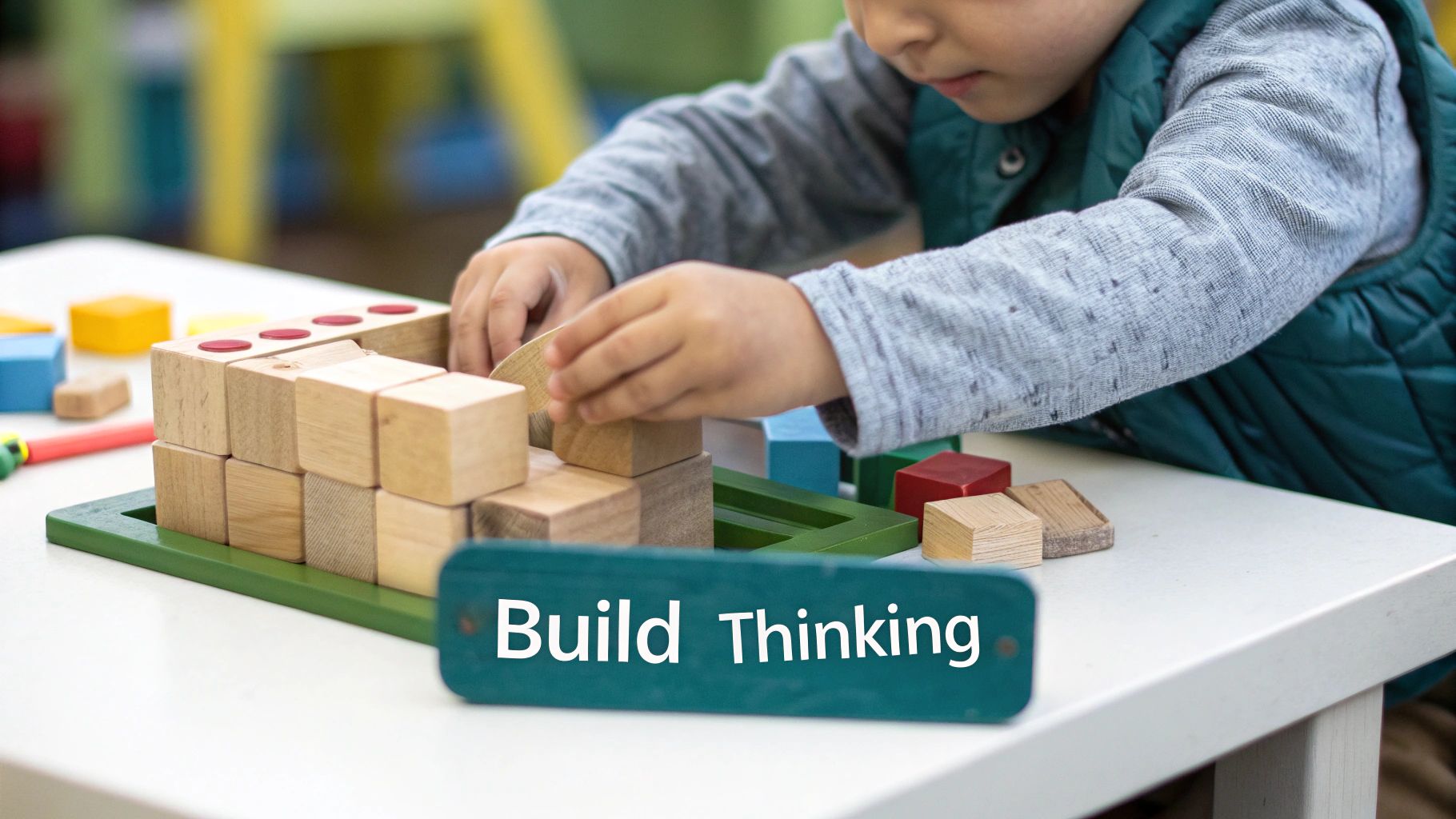
To find the best educational toys for a 2-year-old, it really helps to first get your head around the incredible wiring and rewiring happening inside their brain. At this age, a toddler's mind isn't just growing; it's exploding. They’re like little sponges, soaking up everything through sight, sound, and touch.
For them, play isn't just a bit of fun to pass the time. It’s their full-time job. It’s how they test theories, process information, and build the very foundations of who they will become. Every time they stack a block or babble to a teddy, they are forging new pathways in their brain.
This period is all about massive developmental leaps, and the right kind of play can give them a real leg up.
The Big Three Developmental Leaps
You'll probably notice your two-year-old is juggling three major areas of growth all at once. Think of these as the building blocks for everything that comes next.
- Language Explosion: Their vocabulary is growing at a mind-boggling rate. They're jumping from single words to stringing together short sentences, figuring out how to express what they want, think, and feel.
- Motor Skill Refinement: They're getting the hang of their bodies. This includes big movements (gross motor skills) like running and climbing, as well as the trickier small actions (fine motor skills) like turning a page or picking up a raisin.
- Problem-Solving Sparks: You'll start seeing the gears turn as they figure out cause and effect. They’ll twist a puzzle piece to make it fit or realise they need to stack the bigger blocks on the bottom to stop their tower from toppling over.
This is precisely why simple, open-ended toys often knock the socks off more complex electronic gadgets. A basic set of wooden blocks can become a towering skyscraper, a speeding car, or a fence for toy animals. It stretches their imagination and problem-solving muscles in a way a button-pushing, single-function toy simply can't.
Play is the work of childhood. It is through play that children learn about themselves and the world around them, developing the skills necessary for cognitive, social, and emotional growth.
When you choose toys that tap into these developmental surges, you’re doing so much more than just keeping them busy. You’re giving their developing brain the exact tools it’s hungry for, helping them make sense of their world, one playful moment at a time.
How to Choose the Right Educational Toy for Your Toddler
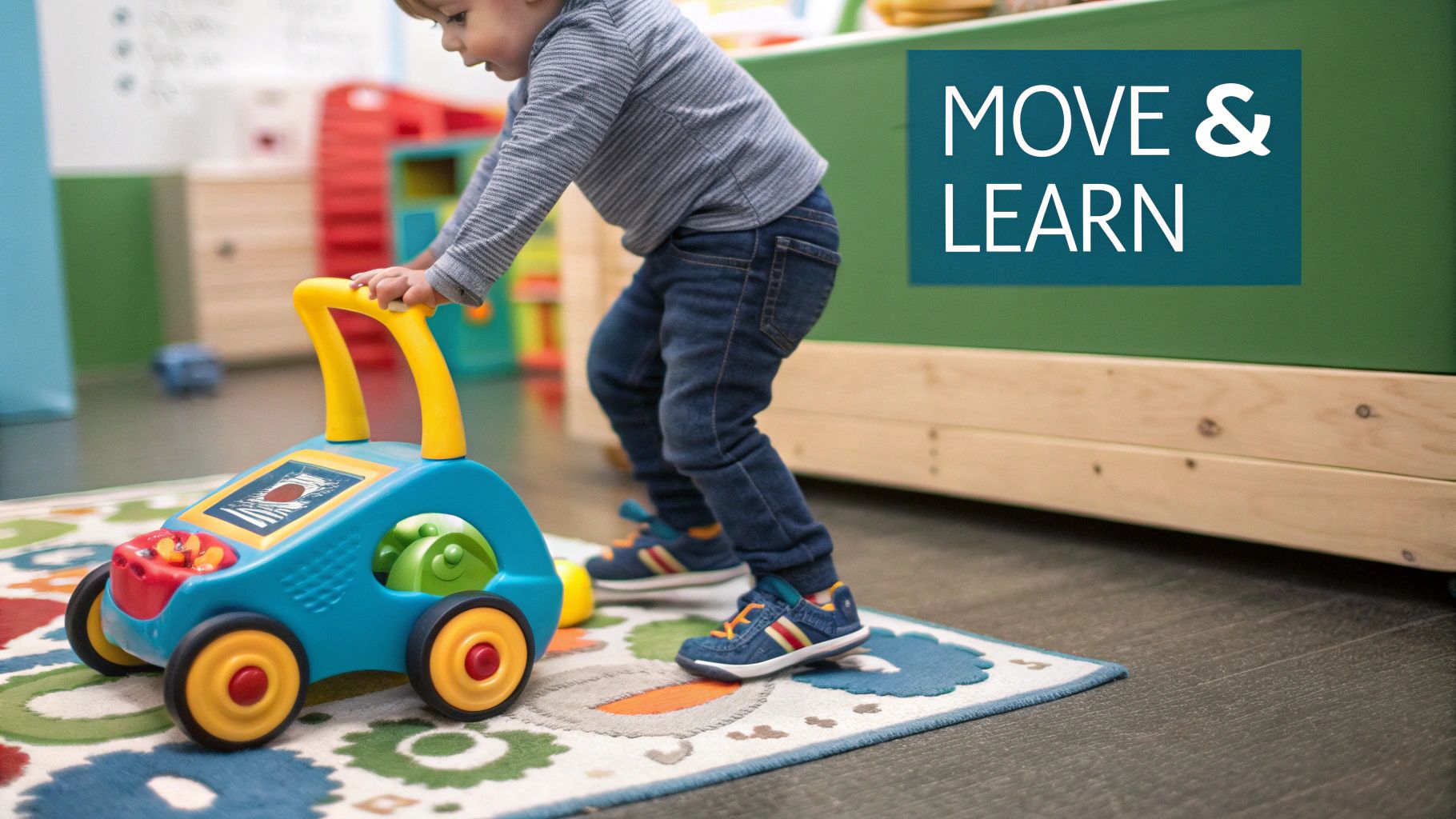
Knowing why educational toys are so important is the first step. The real challenge comes when you’re standing in a shop, surrounded by countless options, trying to pick the perfect one. The goal is to find something that isn't just fun, but is also safe, engaging, and just right for where your toddler is at right now.
It helps to have a simple mental checklist. Think of it as a filter that helps you cut through the marketing noise and focus on what will genuinely enrich your toddler's playtime. It’s the difference between bringing home a five-minute wonder and a treasured favourite.
The Essential Toy Selection Checklist
Before you head to the checkout, take a moment to run through these key points. They'll help you spot the truly great educational toys for your 2-year-old.
-
Safety First and Foremost: This is non-negotiable. Here in the UK, always look for the UKCA or CE mark, which confirms the toy meets strict safety standards. Also, double-check for non-toxic paints and materials and ensure there are no small parts that could be a choking hazard.
-
Built for Toddler Life: Let’s be honest, a two-year-old’s play can be pretty full-on. Durability is a must. You need well-made toys that can handle being dropped, bashed, and enthusiastically explored without breaking into sharp or dangerous pieces.
-
Is it Genuinely Age-Appropriate?: A toy that’s too complex will only cause frustration, but one that’s too simple will be cast aside in minutes. Research has shown time and again that children learn best when they engage fully with toys designed for their specific age group.
An open-ended toy is like a blank canvas for a child's imagination. Unlike a single-purpose gadget that does the "thinking" for them, a set of blocks or simple figures can become anything, empowering your toddler to be the creator of their own play.
Prioritise Open-Ended Play
Often, the most powerful educational toys are the simplest ones. We're talking about open-ended toys—those brilliant items that can be used in a hundred different ways, firing up your child's creativity and problem-solving skills. Classic examples are building blocks, modelling clay, or even a set of toy animals.
The beauty of these toys is that they grow with your child, adapting as their imagination and abilities develop. They invite your toddler to be an active participant, not just a passive observer. For more inspiration on this, have a look at our guide on Montessori toys for toddlers. By keeping these principles in mind, you’ll be well-equipped to choose toys that truly support your child’s amazing development.
Top Toy Categories for Developing Toddler Skills
Okay, so we’ve covered the ‘why’ and the ‘how’ of picking a great toy. Now, let’s get into the ‘what’. When you walk into a toy shop, which aisles should you head to? Think of these categories as the essential food groups for your toddler's developing brain—each one nourishes a different, vital part of their growth.
Building blocks are the undisputed champions of the toy box, and for good reason. Every time your little one stacks a tower or figures out how to balance one block on another, they're getting a practical lesson in physics, spatial awareness, and fine motor control. It's no surprise that 54% of toy buyers in the UK opt for construction toys, making it the most popular category around. You can dig deeper into these toy industry market trends in the UK if you're curious.
At its core, a simple set of blocks is the foundation for early STEM skills and a whole lot of creative thinking.
Fostering Creativity and Cognitive Skills
Puzzles and shape sorters are fantastic for giving their little grey cells a workout. These toys are all about problem-solving, pattern recognition, and getting their hands and eyes to work together as a team. The key here is to start simple—think chunky wooden puzzles with knobs they can actually grab, or basic shape sorters that won't lead to a full-blown meltdown.
And let's not forget art supplies. Chunky crayons, washable paint, and big sheets of paper are more than just an excuse to get messy. They're a brilliant way for your toddler to express the big feelings and wild ideas bouncing around in their head, all while strengthening those tiny hand muscles and building their creative confidence.
Encouraging Social and Sensory Exploration
Imaginative play is where the magic really happens for social and emotional growth. A simple play kitchen, a few dolls, or a collection of toy animals become the props for acting out everything they see in the world around them. This kind of role-playing is how they begin to understand social situations, practise empathy, and try out all the new words they're learning.
Finally, never underestimate the power of sensory play. At this age, learning happens through touch, sight, and sound. Things like play-doh, water tables, or balls with different textures aren't just for fun; they're actively building new connections in the brain's pathways.
The infographic below breaks down how different types of sensory experiences contribute to this crucial development.
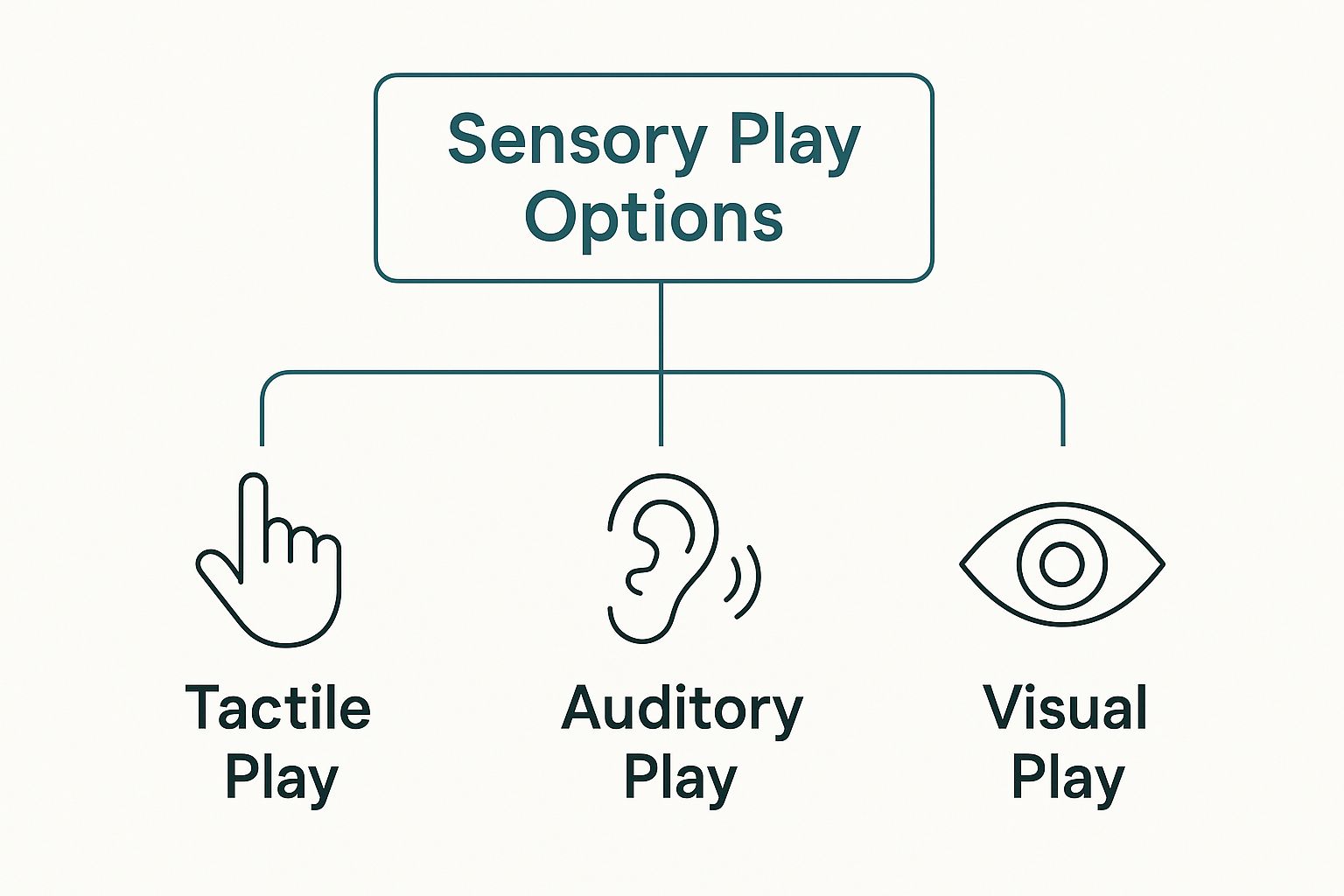
By offering a rich mix of sensory experiences, you’re helping your toddler make sense of their world. Focusing on these core toy types is a sure-fire way to find some of the best educational toys for 2 year olds that they’ll genuinely love and learn from.
To make it even clearer, let’s break down how these different toy types stack up against each other. Each has its own unique strengths, catering to different aspects of your toddler's play and learning.
Comparing Popular Educational Toy Types for Toddlers
| Toy Category | Key Skills Promoted | Best For... | Things to Look For |
|---|---|---|---|
| Building Blocks & Construction Sets | Fine motor skills, spatial reasoning, problem-solving, creativity | Open-ended play and budding engineers. | Sturdy, non-toxic materials (e.g., wood), age-appropriate size, variety of shapes. |
| Puzzles & Shape Sorters | Hand-eye coordination, pattern recognition, logical thinking. | Quiet time activities and developing focus. | Chunky pieces with knobs, simple designs, durable materials. |
| Art Supplies | Creativity, self-expression, fine motor control, colour recognition. | Letting them express their feelings and ideas. | Washable, non-toxic crayons, paints, and large paper sheets. |
| Imaginative Play Items | Social-emotional skills, language development, empathy, storytelling. | Role-playing real-world scenarios. | Simple, durable items like play food, dolls, or toy vehicles. |
| Sensory Toys | Sensory processing, brain development, fine motor skills, calming focus. | Exploring the world through touch, sound, and sight. | Varied textures, safe materials (like play-doh), water tables. |
As you can see, a well-rounded toy collection will include items from several of these categories. It's not about having one 'perfect' toy, but rather providing a variety of tools that help your child build a whole range of skills.
Creating a Playful Learning Environment at Home
While choosing the best educational toys for a 2-year-old is a great start, they're only one piece of the puzzle. The real magic happens when those toys are part of a warm, encouraging home, with you as your child’s favourite playmate.
You are the secret ingredient. Think of the toy as a prop; the real development sparks from the connection you share during playtime. You don't need a huge budget or a picture-perfect playroom to create a space that sparks their curiosity.
It's really all about being intentional. A cosy corner with a few cushions and a basket of books instantly becomes a magical reading nook. A simple trick like toy rotation—where you put some toys away and switch them out weekly—is brilliant for keeping things fresh. It stops your toddler from feeling overwhelmed and makes old toys feel brand new again.
Making Play Interactive and Fun
The way you join in can turn any simple activity into a fantastic learning opportunity. Your job isn't to be a teacher, but more of a co-explorer, discovering things right alongside them. It’s about celebrating their effort, not just what they manage to achieve.
Try weaving these simple habits into your playtime:
- Ask curious questions: Instead of, "Is that a red block?", try asking, "What are you building with that block?" This little switch invites them to think and share their big ideas.
- Be their commentator: Saying things like, "Wow, you're stacking those rings so carefully!" not only builds their vocabulary but also shows you're paying attention to their hard work.
- Use everyday objects: A cardboard box can be a car, a fort, or a spaceship. Pots and pans? They make an excellent drum kit, offering wonderful sensory feedback.
Remember, the main goal of play is connection and joy. Learning is simply the wonderful thing that happens when you spend quality, engaged time together.
At the end of the day, the best toys are just catalysts for creating shared memories. For more inspiration, check out these simple sensory play ideas for toddlers. By focusing on the environment and your interaction, you turn your home into the ultimate playground for growth.
Got Questions? Let's Find Some Answers
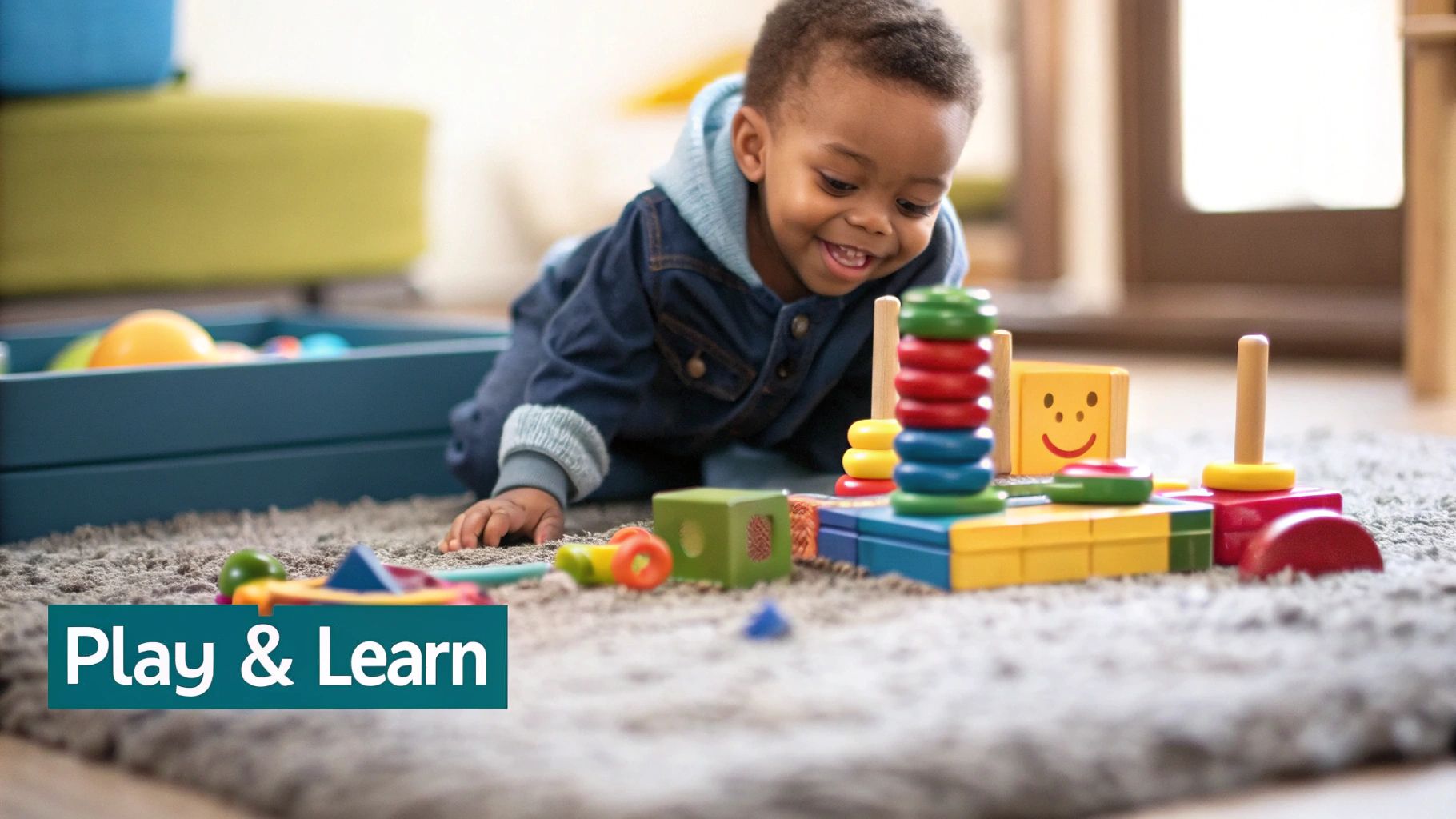
It’s completely normal to have a few questions when you’re trying to pick the perfect educational toys for a 2-year-old. Here are some of the most common queries I hear, along with some practical advice to help you choose with confidence.
How Many Toys Does a 2-Year-Old Really Need?
There’s no magic number here, but I always tell parents to focus on quality over quantity. Honestly, a handful of really good, open-ended toys will do more for your child's development than a playroom overflowing with things that only do one job.
When a child has fewer toys, they tend to play more deeply and creatively with each one. A great little trick is toy rotation – simply pack some toys away for a few weeks and then swap them out. You'll be amazed how this simple act keeps playtime exciting and stops your little one from feeling overwhelmed by too much choice.
By limiting the number of toys available at one time, you encourage your child to explore each one more fully, boosting their creativity and attention span. It makes old toys feel new again.
Are Electronic Toys with Lights and Sounds a Good Idea?
This is a tricky one. While some electronic toys can be fun for introducing letters or colours, many of them create a pretty passive experience. The toy flashes and makes noise, but the child doesn't have to do much thinking. The best toys for this age are the ones that require active participation and get those little problem-solving gears turning.
If you decide to get an electronic toy, try to find one that asks your child to interact and think, rather than just press a button and watch a show. It’s all about finding a healthy balance. Make sure they still have plenty of time with classics like building blocks, simple puzzles, and chunky crayons that truly ignite their own imagination.
What Are the Key Safety Features to Look Out For?
Nothing is more important than safety. When you’re looking at a toy in the UK, the first thing to check for is the UKCA or CE mark. This is your assurance that it has passed rigorous safety standards.
Beyond that official mark, here are a few things to check yourself:
- No Small Parts: My go-to test is the toilet paper tube. If any part of the toy can fit through it, it’s a potential choking hazard for a toddler.
- Non-Toxic Materials: Two-year-olds explore with their mouths! Make sure any paints, plastics, or wood finishes are certified as non-toxic.
- Sturdy Construction: Give the toy a good once-over. It should feel solid, with no sharp edges or flimsy bits that could snap off and become dangerous.
Ready to discover toys that are perfectly matched to your two-year-old’s developmental stage? Grow With Me delivers curated, age-appropriate play kits filled with beautiful, high-quality toys right to your door.
Explore our subscription boxes and start your play adventure today!
